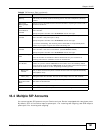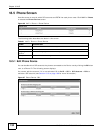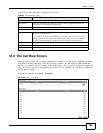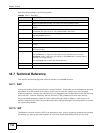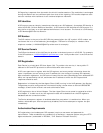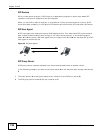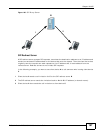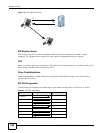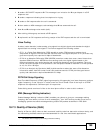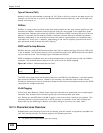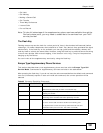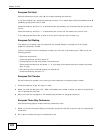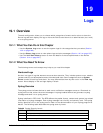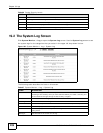
Chapter 18 VoIP
FMG3024-D10A / FMG3025-D10A Series User’s Guide
199
1 A sends a SIP INVITE request to B. This message is an invitation for B to participate in a SIP
telephone call.
2 B sends a response indicating that the telephone is ringing.
3 B sends an OK response after the call is answered.
4 A then sends an ACK message to acknowledge that B has answered the call.
5 Now A and B exchange voice media (talk).
6 After talking, A hangs up and sends a BYE request.
7 B replies with an OK response confirming receipt of the BYE request and the call is terminated.
Voice Coding
A codec (coder/decoder) codes analog voice signals into digital signals and decodes the digital
signals back into analog voice signals. The Device supports the following codecs.
• G.711 is a Pulse Code Modulation (PCM) waveform codec. PCM measures analog signal
amplitudes at regular time intervals and converts them into digital samples. G.711 provides very
good sound quality but requires 64 kbps of bandwidth.
• G.726 is an Adaptive Differential PCM (ADPCM) waveform codec that uses a lower bitrate than
standard PCM conversion. ADPCM converts analog audio into digital signals based on the
difference between each audio sample and a prediction based on previous samples. The more
similar the audio sample is to the prediction, the less space needed to describe it. G.726 operates
at 16, 24, 32 or 40 kbps.
• G.729 is an Analysis-by-Synthesis (AbS) hybrid waveform codec that uses a filter based on
information about how the human vocal tract produces sounds. G.729 provides good sound
quality and reduces the required bandwidth to 8 kbps.
PSTN Call Setup Signaling
Dual-Tone MultiFrequency (DTMF) signaling uses pairs of frequencies (one lower frequency and one
higher frequency) to set up calls. It is also known as Touch Tone®. Each of the keys on a DTMF
telephone corresponds to a different pair of frequencies.
Pulse dialing sends a series of clicks to the local phone office in order to dial numbers.
1
MWI (Message Waiting Indication)
Enable Message Waiting Indication (MWI) enables your phone to give you a message–waiting
(beeping) dial tone when you have a voice message(s). Your VoIP service provider must have a
messaging system that sends message waiting status SIP packets as defined in RFC 3842.
18.7.3 Quality of Service (QoS)
Quality of Service (QoS) refers to both a network's ability to deliver data with minimum delay, and
the networking methods used to provide bandwidth for real-time multimedia applications.
1. The Device does not support pulse dialing at the time of writing.



